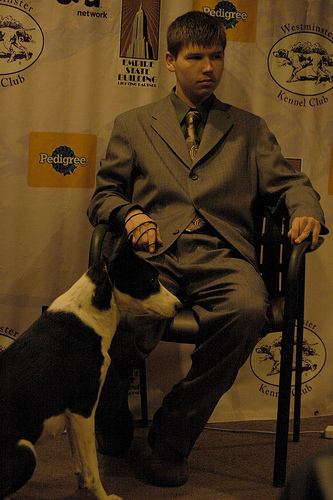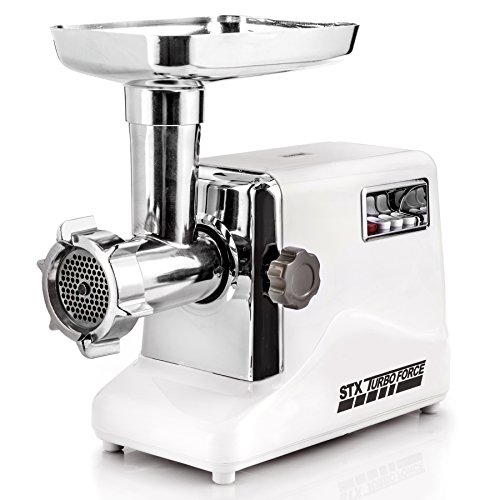
Are you trying to get your puppy to start walking consistently, but not sure what to attach your leash to? Have an older dog who just won’t stop pulling you?
Choosing and using (properly) the right collar or harness for your dog can make a big difference in the way he walks and responds to you during walks.
I had a client once with a pretty large Australian Shepard, about 4 years old. She pulled during her entire walk, every day; if she wanted to go in one direction, we went. I suggested an alternative to her traditional collar- a gentle leader, in this case- to her parents. While they freely discussed her stubbornness and pulling issues, they balked at using anything else- they perceived the gentle leader as cruel.
Down the street, I walk a much larger dog: a Landseer-Newfoundland , who’s about 2. He is not neutered, and weighs 100lbs, so you can imagine the strength I have to contend with when he gets overly excited by something. His parents trained him on a gentle leader; if it weren’t for that, he could easily to leap over my head at the peak of his excitement (and I’m not that short). Even with his weight and hormonal difference, he’s easier to control than the Aussie. Some of that has to do with training, and some of it results from the difference between a collar and a gentle leader.
Other collar options include: Martingale, choke, and prong. While those last two are often thought to be cruel, they are perfectly safe and appropriate, if used correctly. Harnesses are also widely used; most are the same basic design, though there are a couple variations. Each of these collars has advantages and disadvantages; the best way to choose one is to know your dog and know what you need from a collar.
Traditional Buckle Collar: Every dog should wear one of these, with ID tags, at most times. Initially, your dog should wear his at all times to get used to it (except while crated); then, whenever he is outside the home. Our Pit Bull only wears her collar while outside, because any material irritates her highly sensitive skin. Beyond this basic purpose, many dogs are also walked on these collars. If your dog is well trained, pays attention, follows your commands, does not have a pulling problem, etc, great! However, for training purposes, dogs that pull on walks, or for dogs with thick necks or slim heads that may be able to slip out of a collar, others are more appropriate. Buckle collars can actually be more dangerous- rough pulling on one of these can bruise or crush a dog’s trachea, since all the pressure of the collar is applied there.
Slip/Choke Chain: This classic training collar is often misused. Properly fitted, a choke chain should sit right behind a dog’s ears, high on his neck. When a dog pulls, the chain squeezes his neck, momentarily constricting breathing, which is obviously uncomfortable and prompts him to stop. A quick tug on the chain should alert your dog to slow down, pay attention, etc. However, be sure to learn the difference between corrections: tightening the collar in such a way that it squeezes your dog’s windpipe briefly (right way), and jerking on it in a way that puts pressure on the trachea and pulls his head back (wrong way). Choke chains should not be used on young puppies
Prong Collar: Prongs look intimidating, but are just as easy to use and actually more humane than choke chains. Why? Because they only tighten to a point, unlike chokes, which will continue to tighten as long as they are being pulled on. The prongs become uncomfortable quickly, so only very light pressure is necessary to achieve the same purpose. Most of the controversy around these is related to the prongs themselves- they can potentially cut into a dog’s skin, if significant pressure is applied. That is caused by misuse of the collar, not by an inherent danger of the collar itself. Also, one may cover the prong points with rubber caps to protect your dog’s skin from metal. Again, these collars should sit high on the neck directly behind the ears.
Martingale Collar: These collars were designed for dogs whose heads are narrower than their necks (like greyhounds). They also work well for anyone who wants a little more control than a buckle collar, but doesn’t want to use a choke. Martingales are made out of the same nylon/cloth materials as buckle. They employ the same mechanism as the prong does- part of the collar tightens with pulling, but only to a point.
Gentle Leader: This head collar has one strap that goes over the dog’s snout, and another that clasps behind his ears. The strap over the dog’s nose runs through a ring below his snout. When he pulls, this strap tightens and tugs his head down, and the neck strap puts pressure on the back of his neck, rather than the front (much safer). In combination, this collar prevents pulling, aids in teaching your dog to sit (the leader pulls his head up, which naturally guides him into position), and provides control over your dog without any pressure on his neck. People often mistake these for muzzles, but they do not in ANY way restrict your dog’s use of his mouth. Gentle Leaders are very effective, but unfortunately don’t work for dogs with shorter snouts (Boston Terriers, Mastiffs, etc.).
Harness: The basic design of a harness includes a strap around your dog’s chest under his legs and one around the front, below his neck. Most harnesses have a ring on the top side to clip a leash to, though some newer designs place this ring in the front chest strap. Harnesses do not always solve pulling problems, because they still put pressure on the front of the dog, which elicits a counter-pressure response. Again, some newer designs try to solve this issue by attaching a leash in different areas so pressure is moved to other regions of the dog’s body. These are great for small dogs on which other collars don’t fit properly or easily slip off.
There are many, many products out there that fall into each of these categories, so check them out, and be clear on what you need from your dog’s collar. The right choice for your dog will be incredibly helpful, both in training and in long-term walking habits!
For more help, check out these articles:
 Junior Handler Shows Canaan Dog with Seizure Alert Skill - Westminster 2010
Junior Handler Shows Canaan Dog with Seizure Alert Skill
Junior Handler Shows Canaan Dog with Seizure Alert Skill - Westminster 2010
Junior Handler Shows Canaan Dog with Seizure Alert Skill
 Top Seven Dog Treats - A list of the best, most healthy dog treats available
Top Seven Dog Treats
It抯 easy to go to your local pet super
Top Seven Dog Treats - A list of the best, most healthy dog treats available
Top Seven Dog Treats
It抯 easy to go to your local pet super
 Canine Nutrition and Wellness Part 2: Feeding Your Dogs Homemade and Unprocessed Meals
Looking back before commerci
Canine Nutrition and Wellness Part 2: Feeding Your Dogs Homemade and Unprocessed Meals
Looking back before commerci
 Dogs – Canine Rivalry – Dog Fighting
Dogs – Canine Rivalry –
Dogs – Canine Rivalry – Dog Fighting
Dogs – Canine Rivalry –
 Commercial or Raw BARF Diet for Dogs?
Commercial or Raw meat (BARF) diet for dogsIs commercial or
Commercial or Raw BARF Diet for Dogs?
Commercial or Raw meat (BARF) diet for dogsIs commercial or
Copyright © 2005-2016 Pet Information All Rights Reserved
Contact us: www162date@outlook.com